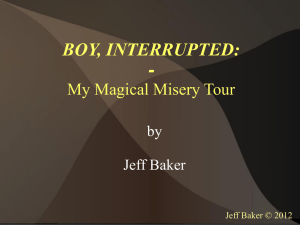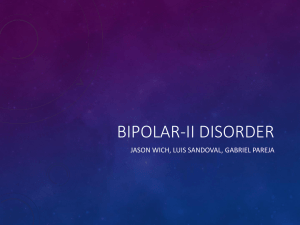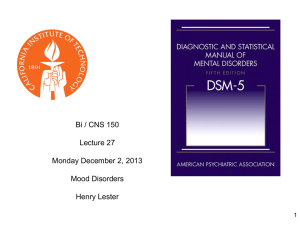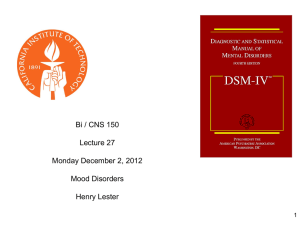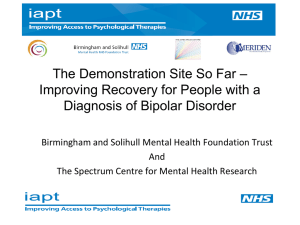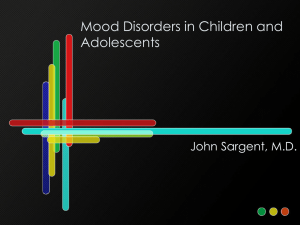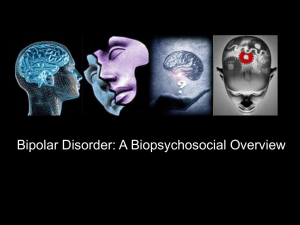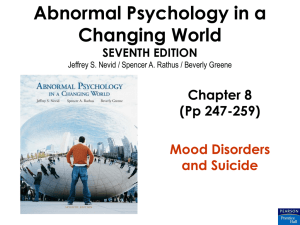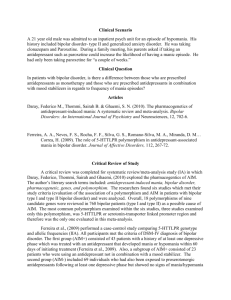Bipolar Disorder - Fulfillment Using Real Conscience
advertisement
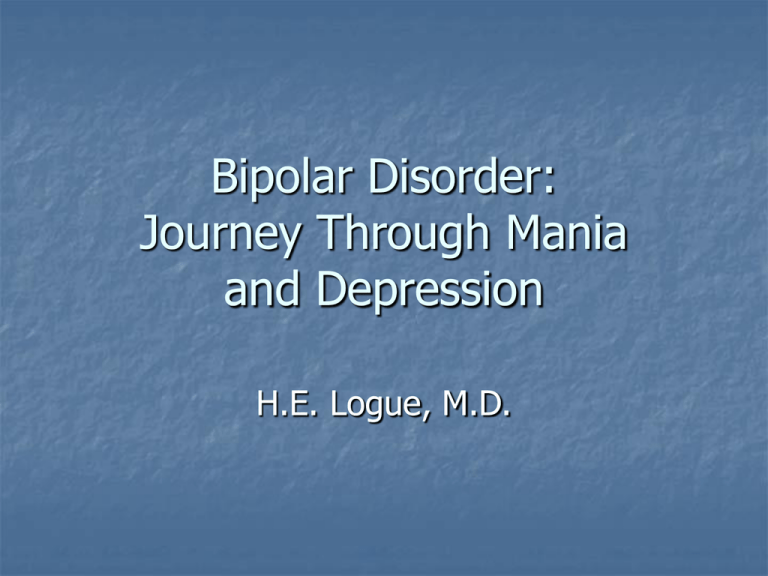
Bipolar Disorder: Journey Through Mania and Depression H.E. Logue, M.D. Bias Disclaimer There is no pharmaceutical support for this program. I am active in the research field and involved in clinical trials for most of the major pharmaceutical companies. Goals and Objectives Promote better understanding of the following aspects of Bipolar Disorder: Prevalence Recognition and Diagnosis Understanding Risk Factors Genetic Predisposition Treatment Considerations Co-morbid Conditions Referral Consideration Victor Hugo Edgar Allen Poe Leo Tolstoy Michelangelo Ezra Pound Charlie Pride Sergey Rachmaninoff Patty Duke Thomas Eagleton Thomas Edison T.S. Eliot Ralph Waldo Emerson William Faulkner Eddie Fisher F. Scott Fitzgerald Betty Ford Harrison Ford Stephen Foster Sigmund Freud King George III Tipper Gore Robert E. Lee Vivian Leigh John Lennon Alexander Hamilton Joan Rivers Norman Rockwell Charles Schultz King Saul William Tecumseh Sherman Neil Simon Rod Steiger William Styron Alfred, Lord Tennyson King Herod Nathaniel Hawthorne Ernest Hemingway Audrey Hepburn Howard Hughes Thomas Jefferson Joan of Arc Lyndon Baines Johnson Danny Kaye Ted Turner Mozart Larry King Jessica Lange Mark Twain Mike Tyson Jean Claude Van Damme Queen Victoria Mike Wallace George Washington Robin Williams Tennessee Williams Thomas Wolfe Virginia Woolf Lord Tennyson Vincent van Gogh Peter Tchaikovsky F. Scott Fitzgerald Charles Dickens Robert Louis Stevenson Walt Whitman Sylvia Plath Marlon Brando Art Buckwald John Bunyan Rodney Dangerfield Charles Darwin King David John Denver Princess Diana of Wales Charles Dickens Emily Dickenson Theodore Dostoevski Jack Dreyfus Richard Dreyfuss Kitty Dukakis Liza Minnelli Carman Miranda Marilyn Monroe J.P. Morgan Ralph Nader Sir Isaac Newton Florence Nightingale Ozzy Osbourne Dolly Parton Boris Pasternak George Patton Jane Pauley Pablo Picasso Cole Porter Abraham Lincoln Joshua Logan Jack London Greg Louganis Martin Luther Imelda Marcos Ann Margaret Herman Melville Burgess Meredith Kurt Vonnegut Vivian Vance Drew Carey Dick Cavett Ray Charles Frederick Chopin Winston Churchill Dick Clark Rosemary Clooney Kurt Cobain Natalie Cole Samuel Coleridge Sheryl Crow Irving Berlin Steven Foster Lord Byron (George Gordon) Noel Coward Alexander the Great Edwin “Buzz” Aldrin Hans Christian Anderson Roseanne Barr Ludwig Von Beethoven William Blake Napoleon Bonaparte Prevalence Bipolar Disorder affects approximately 5.7 million adult Americans The median age of onset for Bipolar Disorder is 25 years. An equal number of men and women develop Bipolar Disorder and it is found in all ages, races, ethnic groups and social classes. Bipolar Disorder is the sixth leading cause of disability in the world. Bipolar Disorder results in 9.2 years reduction in expected life span, and as many as one in five patients with bipolar disorder completes suicide. Bipolar Disorder Subtypes Classic Bipolar Disorder Bipolar I Bipolar II Subtypes Cyclothymia Major Depression Unipolar/Recurrent Dysthymic Disorder Bipolar NOS (Not Otherwise Specified) Other Considerations Rapid Cycling (part of Bipolar I) Post-partum Onset Seasonal Pattern Mood Disorders DSM-IV Criteria - Depression Five or more of the following: Depressed mood Diminished interest or pleasure in activities Significant weight loss/gain or decrease/increase in appetite Insomnia or hypersomnia Psychomotor agitation or retardation Fatigue or loss of energy Feelings of worthlessness or excessive or inappropriate guilt Diminished ability to think or concentrate, or indecisiveness Recurrent thoughts of death, recurrent suicidal ideation without a specific plan, or a suicide attempt or a specific plan for committing suicide. Diagnostic Dilemmas Secondary Depression Depression with… Other psychiatric illnesses Schizophrenia Anxiety Personality Disorders Panic disorder Obsessive-compulsive disorder Borderline Compulsive Post-traumatic stress disorder Post-partum depression Grief/depression Practically any psychiatric disorder Depression with… Organic/Medical Illnesses Hypothyroidism B-12 deficiency Folate deficiency Tuberculosis Myasthenia gravis Diabetes mellitus Hepatitis C Cushing’s disease Mononucleosis Parkinson’s disease CHRONIC FATIGUE SYNDROME DSM-IV Criteria - Mania Three or more of the following: Inflated self-esteem or grandiosity Decreased need for sleep More talkative than usual or pressure to keep talking Flight of ideas or subjective experience that thoughts are racing Distractibility Increase in goal-directed activity or psychomotor agitation Excessive involvement in pleasurable activities that have a high potential for painful consequences Mood Symptoms Euphoria/Mania Depression (in mixed state) Anxiety Anger Hostility Irritability Behavioral Symptoms Energized Activity Diminished Need to/for Sleep Impulsivity Anger with Violence Elevated Libido Diminished Inhibitions Reckless Behavior Cognitive Symptoms Racing Rapid Thoughts Diminished Insight/Invincibility Sensory Hyperacuity Hallucinations Delusions Perceptual Distortions Distractible Disorganized Thoughts S-H-O-T S: Symptomatology H: History What is the history of the person? The history of the family? Is there a family history of mood swings, mood disorders, substance abuse in persons with mood disorders or Bipolar diagnosis? O: Ongoing illness Do the symptoms appear to be manic or depressed or repeated episodes of depression or mania or continuing mood swings? What is the progression of the illness? What is the course of the disease? Does it continue to go on in a progression appearing as a Bipolar disease course? T: Treatment response If one looks at the response of the treatment one should get a good deduction as to the nature of the illness. Understanding Risk Factors Stress (major or prolonged) Sleep Deprivation/Disruption Alcohol (major problem) “Recreational” Drug Use Discontinuation of Medications Loss or Perceived Loss (job, family, friends, finances, health, etc.) Interpersonal Conflict Travel Across Time Zones Mood-Altering Medications (benzodiazepines, antidepressants, antipsychotics) Death of Loved One or Friend Inadequate Coping Skills Early Dementia or Minimal Brain Damage Treatment Depression vs. Bipolar Depression Depression: Pre-Modern Era Tincture of Time Insulin shock Electric shock Spiritual Education and Psychotherapy Pharmacotherapy Physical Social Mental Somatic Depression: Modern Era Prescribed trip to Europe Activity 1950’s – Tricyclics 1960’s – Tetracyclics, etc. 1990’s – SSRIs (Prozac, Paxil, Zoloft) SNRI (Wellbutrin) SSNRIs (Effexor, Remeron, Cymbalta) Spiritual Treatment Statistics Patients with Bipolar Disorder face up to ten years of coping with symptoms before receiving an accurate diagnosis. Nearly 9 out of 10 patients with bipolar disorder are satisfied with their current medication(s), although side effects remain a problem. Participation in a Depression and Bipolar Support Alliance patient-to-patient support group improved treatment compliance by almost 86% and reduced in-patient hospitalization. Consumers who report high levels of satisfaction with their treatment and treatment provider have a much more positive outlook about their illness and their ability to cope with it. Bipolar Disorder Type II (Depressed Type) Incorporate all of the previous slide Recent studies suggest antidepressants cause a sooner relapse or conversion to mania Treating the Bipolar component is equivalent to casting both broken legs. Mood stabilizers Antidepressants Lithium – only drug proven to reduce suicide rate 1950’s – Richard Dreyfuss 1990’s – Depakote, Tegratol, Trileptal, Lamictal Atypicals? Bipolar Disorder Type I (Manic and Depressive) Mania Antipsychotics 1953 – Thorazine/chlorpromazine Zyprexa, Seroquel, Abilify, Risperdal, Geodon Risk and Benefits Anticonvulsants Risk and Benefits Atypical Antipsychotics World’s first psychotropic medication Could treat psychosis and mania Other conventional antipsychotics followed Depakote, Tegratol, Trileptal, Lamictal Risk and Benefits Electroconvulsive Therapy Genetics Like the illness, a complicated topic… Confounding issues: Hypersexuality Family disintegration Separation of siblings Twins Genetic Models Mendelian vs. Polygenic Models 1 2 1 1 affected parents = 1 in 4 affected offspring affected parents = 2 in 3 affected offspring dizygotic/fraternal twin = 1 in 6 affected twin monozygotoc/identical twin = 2 in 3 affected twin Epistatic Model Number 22 is prominently mentioned (same gene as schizophrenia Gene 21q is also involved Genes 18p and 18q also are involved


